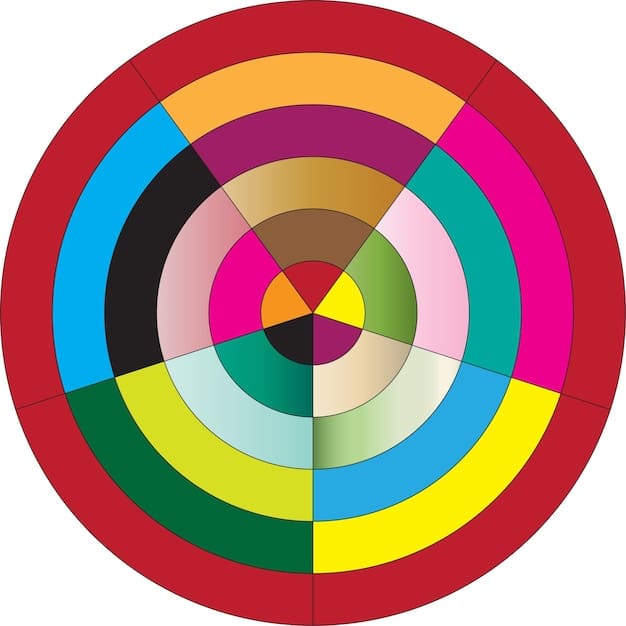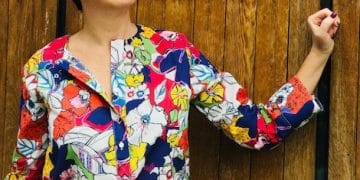Color Theory for Clothing: Create Harmonious Outfits

Color Theory for Clothing: A Practical Guide to Creating Harmonious Outfits explains how to use the color wheel, understand color harmonies, and apply these concepts to build stylish and balanced outfits, enhancing your personal style.
Ever wondered how some people effortlessly put together outfits that look amazing? Often, the secret lies in understanding Color Theory for Clothing: A Practical Guide to Creating Harmonious Outfits. It’s not just about matching colors; it’s about creating visual harmony.
This guide will break down the essential concepts of color theory and show you how to use them to build a wardrobe that reflects your style and makes you feel confident. Ready to unlock the secrets of color and elevate your fashion game?
Understanding Color Theory for Clothing: A Practical Guide to Creating Harmonious Outfits
Color theory might seem like a complex topic reserved for artists and designers. However, it’s surprisingly practical for everyday life, especially when it comes to choosing what to wear. Understanding the basics can transform your wardrobe and help you create outfits that are visually appealing and reflect your personal style. This section provides a foundational approach to Color Theory for Clothing: A Practical Guide to Creating Harmonious Outfits.
The Color Wheel: Your Fashion Companion
The color wheel is the foundation of color theory. Understanding its components is crucial for creating harmonious outfits. Here’s what you need to know:
- Primary Colors: Red, blue, and yellow are the building blocks of all other colors.
- Secondary Colors: Mixing two primary colors creates secondary colors: green (blue + yellow), orange (red + yellow), and purple (red + blue).
- Tertiary Colors: These are created by mixing a primary color with a neighboring secondary color, such as red-orange, yellow-green, and blue-violet.
Key Color Characteristics for Clothing Choices
Beyond the basics, understanding the characteristics of different colors is key to mastering Color Theory for Clothing: A Practical Guide to Creating Harmonious Outfits. Hue, saturation, and value all play a role in how colors interact:
- Hue: This is the pure color, like red, blue, or green.
- Saturation: This refers to the intensity of a color, ranging from pure color to a muted, desaturated version.
- Value: This is the lightness or darkness of a color, ranging from white to black.
Understanding these characteristics helps you select colors that complement each other and work well with your skin tone and personal style.

In conclusion, understanding the color wheel and key color characteristics are fundamental to effectively applying color theory in fashion. This knowledge empowers you to make informed decisions, leading to more stylish and harmonious outfits.
Exploring Color Harmonies in Fashion
Now that you understand the basics of the color wheel, let’s dive into color harmonies. These are tried-and-true combinations that create visually pleasing outfits. Exploring color harmonies is a critical component of using Color Theory for Clothing: A Practical Guide to Creating Harmonious Outfits.
Monochromatic Harmony: Simplicity at Its Best
Monochromatic outfits use different shades and tints of the same color. This creates a sophisticated and streamlined look.
- Choose a Base Color: Select a color that you love and that complements your skin tone.
- Vary the Shades: Incorporate lighter and darker shades of your base color to add depth and dimension.
- Add Texture: Use different textures to keep the outfit interesting, such as a knit sweater with silk pants.
Analogous Harmony: Colors That Play Well Together
Analogous colors are those that are next to each other on the color wheel, like blue, blue-green, and green. This harmony is easy to achieve and creates a harmonious and balanced look.
- Select a Dominant Color: Choose one color to be the main focus of your outfit.
- Use Supporting Colors: Add the neighboring colors as accents.
- Keep It Simple: Avoid using too many analogous colors to prevent the outfit from looking overwhelming.
Complementary Harmony: Bold and Eye-Catching
Complementary colors are opposite each other on the color wheel, like red and green or blue and orange. This combination creates a vibrant and energetic look, but it can be tricky to pull off.
- Balance Is Key: Use one color as the main focus and the other as an accent.
- Consider Value and Saturation: Opt for a muted version of one color and a brighter version of the other.
- Neutralize: Ground the outfit with neutral colors like white, black, or gray.
Mastering these color harmonies can significantly enhance your ability to create stylish and visually appealing outfits. By understanding how colors interact, you can confidently express your personal style and create outfits that are both harmonious and eye-catching.
Applying Color Theory for Clothing: A Practical Guide to Creating Harmonious Outfits in Your Wardrobe
Knowing the theory is one thing, but applying it to your wardrobe is where the magic happens. This section focuses on practical tips for using Color Theory for Clothing: A Practical Guide to Creating Harmonious Outfits to elevate your style. We’ll cover how to assess your current wardrobe, how to choose colors that suit you, and how to create outfits that reflect your personal style.
Assessing Your Current Wardrobe Palette
Before making any changes, take stock of what you already have. This will help you identify gaps and make informed decisions about what to add.
- Inventory: Lay out all your clothes and accessories to get a clear picture of what’s in your current wardrobe.
- Color Analysis: Sort your clothes by color and identify the dominant hues.
- Identify Gaps: Note which colors are missing and which ones you need more of.
Choosing Colors That Flatter Your Skin Tone
Understanding your skin tone is essential for choosing colors that make you look and feel your best. There are two main skin tone categories: warm and cool.
Colors interact differently with warm and cool skin tones, therefore understanding your skin tone is an imporant consideration in Color Theory for Clothing: A Practical Guide to Creating Harmonious Outfits.
- Warm Skin Tones: Typically have yellow or golden undertones and look great in warm colors like red, orange, yellow, and olive green.
- Cool Skin Tones: Have pink or blue undertones and shine in cool colors like blue, purple, silver, and emerald green.
Building Outfits with Confidence
Now that you know what colors you have and which ones suit you, it’s time to start building outfits. Consider the following tips:
- Start with a Neutral Base: Begin with neutral pieces like black pants, a white shirt, or a beige skirt.
- Add a Pop of Color: Incorporate a colorful top, scarf, or pair of shoes to add interest.
- Accessorize Wisely: Use accessories to tie the outfit together, paying attention to color and texture.
By applying these practical tips, you can transform your wardrobe into a collection of stylish and harmonious outfits. Remember that Color Theory for Clothing: A Practical Guide to Creating Harmonious Outfits is a tool to guide you, not restrict you. Experiment and have fun!
Common Mistakes to Avoid When Using Color Theory for Clothing
While understanding color theory can significantly improve your style, there are common pitfalls to watch out for. This section highlights mistakes to avoid when using Color Theory for Clothing: A Practical Guide to Creating Harmonious Outfits so you can ensure every outfit is a success.
Overdoing Complementary Colors
Complementary colors can be striking, but using them incorrectly can lead to a visually jarring outfit. The key is balance.
Overusing complementary colors can create a sense of visual dissonance, which is why balance is essential in Color Theory for Clothing: A Practical Guide to Creating Harmonious Outfits.
Ignoring Proportion
Wearing equal amounts of two complementary colors can be overwhelming.
- Solution: Choose one color to be the dominant one and use the other as an accent. For example, wear a navy blue dress with a small orange scarf.
Neglecting Saturation and Value
Bright, saturated colors can be overwhelming when paired together without any variation.
- Solution: Mix high-saturation colors with muted tones or neutrals to create balance. For example, pair a bright red top with gray pants or a denim skirt.
Wearing Too Many Colors at Once
A rainbow of colors might seem fun, but it can easily look chaotic and disorganized.
- Solution: Stick to a maximum of three colors in one outfit to maintain a cohesive and polished look. This helps in executing Color Theory for Clothing: A Practical Guide to Creating Harmonious Outfits effectively.
Ignoring Your Skin Tone
Wearing colors that clash with your skin tone can make you look washed out or unwell, even if the colors are theoretically harmonious.

By being aware of these common mistakes, you can avoid them and use color theory to create outfits that are stylish, flattering, and harmonious. The goal is to enhance your personal style, not to be restricted by rigid rules.
Beyond the Basics: Advanced Color Theory Concepts for Clothing
Once you’ve mastered the fundamentals of color theory, you can explore more advanced concepts to take your style to the next level. These advanced ideas can truly enhance how you apply Color Theory for Clothing: A Practical Guide to Creating Harmonious Outfits.
Understanding Color Temperature
Colors can be broadly divided into warm and cool tones. Warm colors (red, orange, yellow) tend to feel energetic and inviting, while cool colors (blue, green, purple) are often calming and sophisticated.
Balancing color temperature is a key factor in Color Theory for Clothing: A Practical Guide to Creating Harmonious Outfits, as it affects the overall mood and impact of your look.
Using Color to Create Focal Points
Strategically using color can draw attention to specific areas of your body or outfit. A bright-colored top can highlight your face, while a statement accessory can add a touch of personality.
- Highlight Your Best Features: Wear brighter or more saturated colors on areas you want to emphasize.
- Draw Attention Away from Problem Areas: Use darker or more muted colors on areas you want to minimize.
Experimenting with Unexpected Color Combinations
While classic color harmonies are a safe bet, don’t be afraid to experiment with unconventional pairings. Sometimes, the most interesting outfits come from unexpected color combinations.
- Try Triadic Colors: These are three colors that are equally spaced on the color wheel, like purple, orange, and green.
- Consider Tetradic Colors: This harmony uses two pairs of complementary colors, offering even more possibilities.
Exploring these advanced concepts can help you to further refine your sartorial sense and create looks that are uniquely yours. Don’t be afraid to try new things, and most importantly, have fun with it!
| Key Point | Brief Description |
|---|---|
| 🎨 Color Wheel Basics | Understanding primary, secondary, and tertiary colors for creating harmonious outfits is crucial. |
| 🌈 Color Harmonies | Explore monochromatic, analogous, and complementary color schemes to build balanced looks. |
| 👗 Wardrobe Application | Assess your wardrobe, choose flattering colors, and confidently create stylish outfits. |
| 🚫 Avoiding Mistakes | Avoid overdoing complementary colors, ignoring skin tone, and wearing too many colors. |
Frequently Asked Questions about Color Theory in Clothing
Color theory in clothing involves understanding how colors interact and combining them to create visually appealing outfits. It’s about using the color wheel and color harmonies to enhance your personal style.
Check the undertones of your skin. Warm skin tones have yellow or golden undertones, while cool skin tones have pink or blue undertones. Look at your veins; blue veins indicate cool undertones and your jewelry preference; gold means warm and silver signals cool.
Start with monochromatic outfits (different shades of the same color) or analogous combinations (colors next to each other on the color wheel). These are simple ways to apply Color Theory for Clothing: A Practical Guide to Creating Harmonious Outfits.
Yes, everyone can wear black! If you have a warm skin tone, pair it with warm-toned accessories or clothing items close to your face to balance the look. Layer a mustard scarf to keep the look warm and inviting.
Accessories are great for adding a pop of color or completing a color harmony. Use them strategically to balance the outfit, highlight your favorite features, or add a touch of personality, while using Color Theory for Clothing: A Practical Guide to Creating Harmonious Outfits.
Conclusion
Understanding Color Theory for Clothing: A Practical Guide to Creating Harmonious Outfits can revolutionize your style. By mastering the color wheel, exploring color harmonies, and avoiding common mistakes, you can curate a wardrobe that reflects your personality and makes you feel confident.





